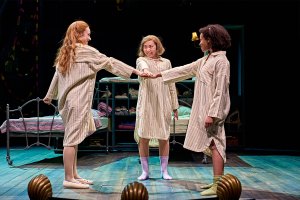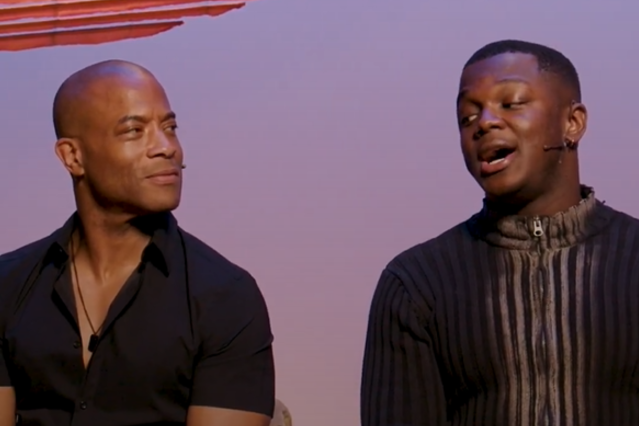Where have all the women gone?
On International Women’s Day, read an extract of Lucy Kerbel’s new book ”All Change Please” on how to achieve gender equality in the theatre industry

© Helen Murray 2016
Lucy Kerbel is the founder and director of Tonic Theatre, a company dedicated to achieving greater gender balance in the theatre industry. She works closely with organisations such as the National Theatre and the RSC to help ensure a greater level of of female talent can make it to the top. The below piece is an extract from her new book All Change Please which acts as a practical guide to achieving Tonic's goals.
Where have all the women gone?
I’ve been involved in theatre since I was tiny. Drama classes, youth theatre, school plays, drama at GCSE, BTEC, and degree level: you name it, I was doing it. As a young adult I crewed at my local theatre, shifting the scenery and operating the follow-spot for amateur theatre companies, and began teaching drama to children myself. In every one of these scenarios there was one thing that was consistent: the number of female participants always significantly outstripped the number of male.
So I was surprised, upon eventually reaching professional rehearsal rooms, to find the opposite was true: repeatedly the number of men taking part exceeded the number of women. Yes, the stage-management team often tended to be female, and set and costume designers seemed to be women roughly half the time. But in terms of everyone else in the room – the actors and the rest of the creative-team members – it was like the ratio of men to women had been flipped. Where had all the girls and women gone who I’d watched rehearse scenes and paint scenery and put musical numbers up on their feet in the school halls and community centres of my childhood and adolescence? Why were women now the minority?
Somewhere along the way we must be letting artists with the potential to be excellent slip through our fingers
A short walk out of the rehearsal room and into the admin offices of a theatre and I found where the women had ended up: largely behind desks. I’m not dismissing a desk job in theatre (I myself traded in a rehearsal-room-based job for an office-centred one when I put aside directing to found and run my organisation Tonic Theatre, which works across the UK theatre industry, supporting it to achieve greater gender equality in its work and workforces), but still it was puzzling. I’d never noticed a lack of interest in artistic roles among my fellow females when we were taking part in theatre on an amateur level. Why, apparently were they suddenly so keen to leave that to the guys and get behind a desk when it came to being involved in professional theatre?
What I’m not saying here is that women don’t work in artistic roles in theatre. They do. The industry is full of women who write, act, direct, design, choreograph and compose. I am also not saying that they don’t make work. They do. However, the point is that when it comes to who is making work on the biggest, best resourced, and/or most visible professional stages in our country, women are significantly less likely than men to be getting those jobs.
Some people will ask whether the gender imbalance between administrative and artistic roles matters
Sometimes when I’m speaking with the leaders of theatres about the potential for them to work with Tonic, I’ll be politely turned down with an explanation along the lines of 'we’re already a very female organisation'. A quick look on the staff list on their website will certainly confirm that yes, in terms of who’s working in administrative areas – by which I include fields such as general management, finance, producing, fundraising and marketing – it certainly is. Do a scan of who’s being employed by them in artistic roles though – to perform, direct, design or write the productions that their audiences get to see – and often it’s the inverse. Sometimes I’ve worked with theatres that have been quite shocked when they’ve done a simple tally of how many men compared to women they’ve employed in artistic roles over the past few years, finding it to be significantly less balanced than they’d thought it would be. It’s really easy, when from Monday to Friday the offices of your organisation are filled with women, not to clock that this doesn’t automatically translate to the balance of the artistic programme your audience experiences in the evenings.
Some people will ask whether the gender imbalance between administrative and artistic roles matters. So long as there are roughly equal numbers of men and women in the theatre workforce as a total, is there a problem? I would argue though that it is worth our attention. When it comes to the direct interface between a theatre and the public – i.e. what an audience hears and sees when it sits in the auditorium – if the voices, ideas, stories and creativity of women aren’t at the forefront of this in the same way as men’s, then something isn’t working as well as it could be. Beyond this, the currently imbalanced numbers would suggest that as an industry we’re failing to spot or nurture some of our best theatre artists. All that passion for acting, directing, writing, designing, choreographing and composing exhibited by girls and young women at student and entry level can’t be without merit. Somewhere along the way we must be letting artists with the potential to be excellent slip through our fingers.
When it comes to establishing greater equality and diversity in any field, one of the best places to focus is on leadership
But perhaps more than any other reason why it’s important to note and address this particular imbalance is this: the greater likelihood of men taking up artistic roles and women administrative ones is something that filters upwards through organisations and finds expression at their top level; in leadership. That’s of especial interest because, when it comes to establishing greater equality and diversity in any field, one of the best places to focus is on leadership. It is where power lies.
When it comes to selecting an artistic programme and setting a creative agenda for an organisation, artistic directors hold the lion’s share of decision-making powers. Executive directors, while having significant amounts of power and responsibility, essentially deliver that vision. What this means is that a large proportion of what makes its way on to public stages across the country is something that is heavily decided by the tastes, interests and passions of artistic directors. If people in artistic director roles belong overwhelmingly to a single demographic – whatever that demographic may be – the artistic programmes that audiences have access to is less likely to be as broad and varied as it would be had it been created and curated by a less homogenous group of people.
I would argue that there are a whole range of things that many of us can do to create shifts

Getting more women, and the broadest range of women, into artistic director roles may feel like something few of us have control over. Ultimately, it’s up to a theatre’s board to decide who to appoint whenever its artistic director post becomes available. Yet I would argue that there are a whole range of things that many of us can do to create shifts so that, cumulatively, we maximise promising individuals’ potential to move into artistic-director roles, regardless of their gender. You’ll find lots of ideas in my new book, All Change Please: A Practical Guide to Achieving Gender Equality in Theatre.
It goes without saying that we’ll be building on a really strong foundation. The last five or so years has seen a significant new generation of female artistic directors coming into post – including at several key venues nationally – joining the ranks of trailblazers that have gone before them. The precedent is there; now we just need to work out how to expand on and consolidate it.
By Lucy Kerbel
This is an edited extract from All Change Please: A Practical Guide to Achieving Gender Equality in Theatre by Lucy Kerbel, £9.99 paperback, out now, published by Nick Hern Books.












